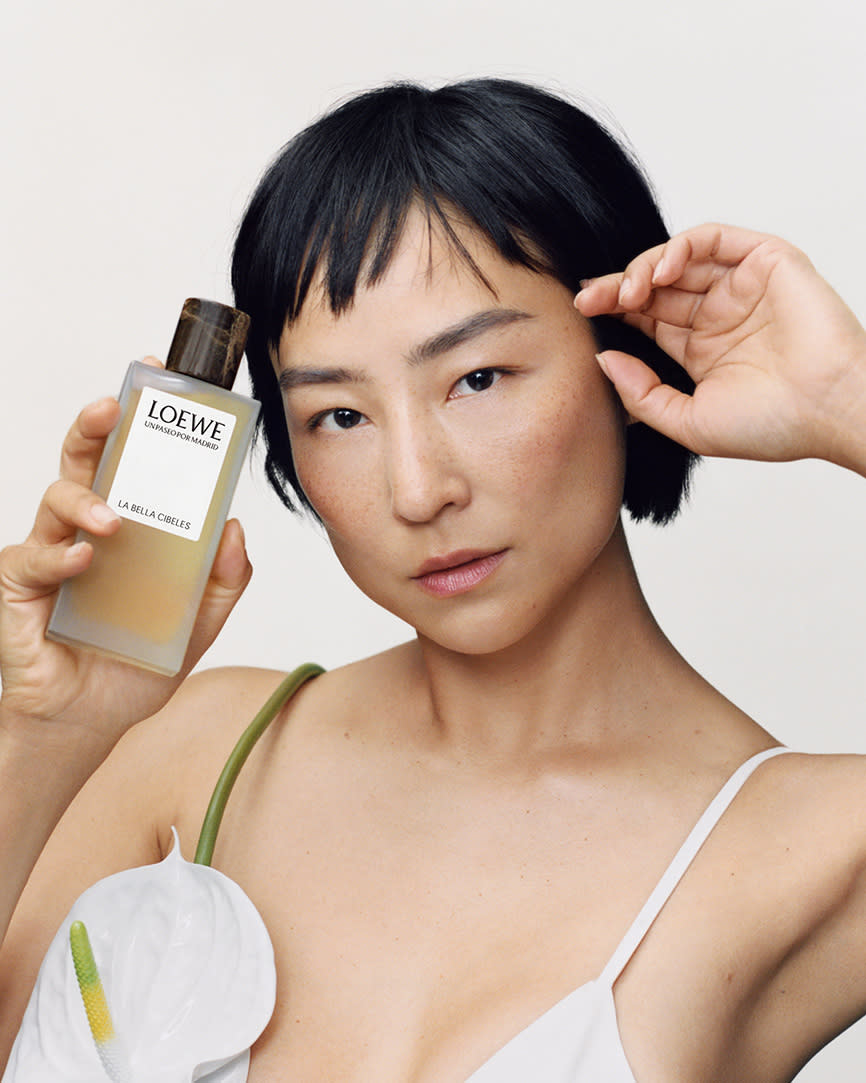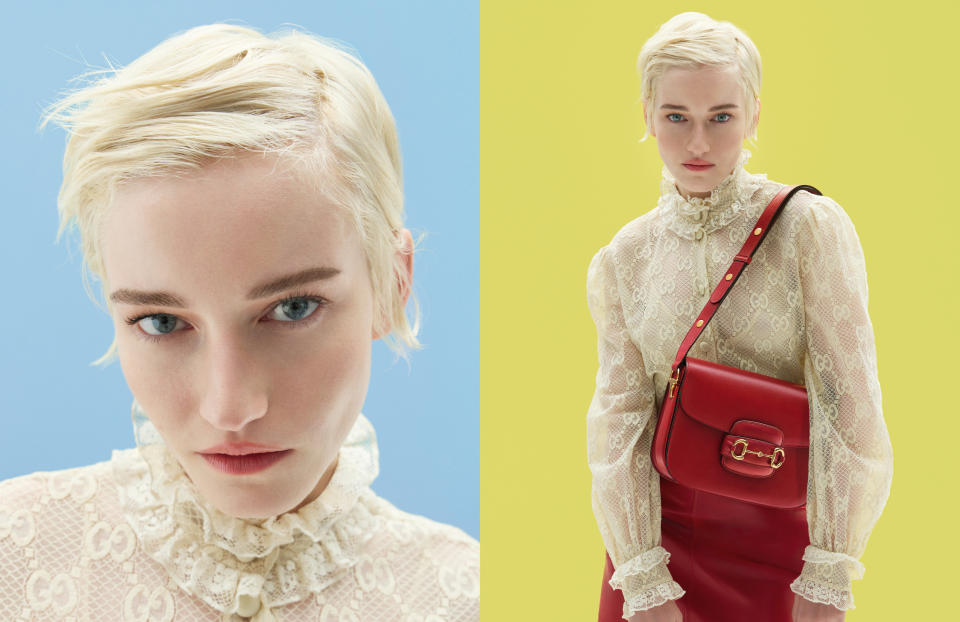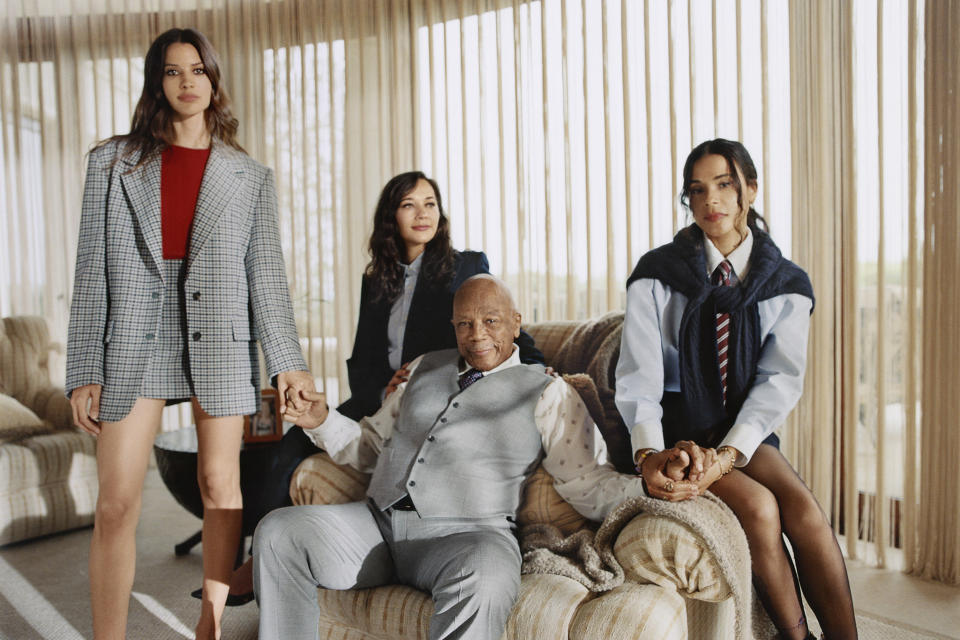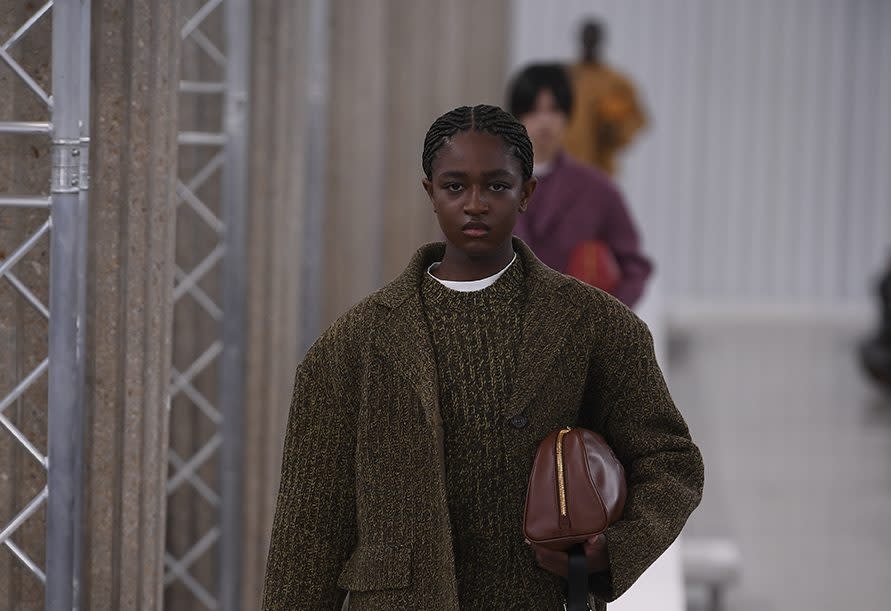How UTA’s Dan Constable Put the Hollywood Agency on the Luxury Fashion Map
- Oops!Something went wrong.Please try again later.

When Julia Garner waded through flashbulbs into the Gucci runway show in Milan last Friday, walking close beside her was the Hollywood agent who helped her get there: United Talent Agency’s Dan Constable.
At Prada, he was sitting two rows behind Benedict Cumberbatch, having orchestrated the deal that made the British actor the face of the current men’s campaign. And at Peter Hawkings’ debut at Tom Ford, he was escorting the global face of Armani Beauty: Adria Arjona.
More from WWD
Macron's Fashion Party, Chanel's Front Row, Dior Taps James Deeny
Barbie Girl and Birthday Girl: Jennie and Brie Larson at Chanel's Front Row
A senior agent in the endorsements group at UTA, Constable spearheads fashion and luxury deals for the division, working closely with fashion houses.
He brokered Timothee Chalamet’s reportedly $35 million Bleu de Chanel fragrance deal, made Zaya Wade’s runway modeling dreams come true at Miu Miu, and pulled together 22 Joneses, including Quincy, Rashida and Kidada, for Tommy Hilfiger’s fall 2023 friends and family campaign.
Constable’s work on behalf of his clients and agency is critical in today’s fragmented entertainment industry, when executives and creators are searching for ways to make a profit in a less profitable business. Endorsement deals and brand building are often more lucrative than acting paychecks. For example, Dwayne “The Rock” Johnson made $270 million in 2022, making him the highest-paid actor according to Forbes, but the majority of his earned income came from his tequila brand, Teremana.
“The right brand partnership can offset things financially…these aren’t professional spokespeople. They’re actors first and foremost and this is ancillary to that. But in the last five to six years, I’ve noticed it become perhaps of equal importance,” said Constable, who has increased the volume of UTA’s fashion business with several high-profile deals, and has a reputation for being a good guy, which doesn’t come easy in talent representation circles.
Demand for what he does has grown since Hollywood productions have been halted due to labor strikes.
“There is more interest among talent in finding a space in fashion than ever before. People are available, and the interest is there, so it’s been quite busy,” Constable said when he landed in New York to hit the Ralph Lauren show with Gabrielle Union at the start of his Fashion Month.
“He’s been doing this for years, but suddenly UTA, probably because of him, is at the forefront,” said stylist Elizabeth Saltzman, whose clients include Garner, Jodie Comer and Gwyneth Paltrow among others. “He’s a secret weapon: friendly, empathetic, honest, not a wheeler-dealer.…I have known him for years and watching how he listened to Julia, for example, and said what about this. And when someone is not feeling it, that’s OK. He’s made some smart, lucrative partnerships where people aren’t changing every three months. Thoughtful partnerships versus a business deal.”
Constable has worked closely with designer Jonathan Anderson, who cast three of his clients in campaigns — Greta Lee, Taylor Russell and Jamie Dornan.
“Dan and I first met on a campaign shoot at Luca Guadagnino’s home in Italy and since then he’s become a close friend of the house. A wonderful curator and connector, he’s someone who really opens doors between different worlds — it has been exciting to collaborate with his incredible roster of talent,” Anderson wrote in an email.

At the intersection of Hollywood and fashion, there are several key players that work with luxury brands and have talent attending or walking runway shows.
Creative Artists Agency has been in the news recently, after being acquired by Pinault family-owned Artemis, parent of Kering, and industry watchers wondering how the deal could alter the dealmaking power structure. Longtime client Julia Roberts was a new CAA face to the Gucci front row this season. CAA clients and friends-of-the-house Ryan Gosling, Jessica Chastain and Mark Ronson were also at the show, which marked Sabato De Sarno’s debut as creative director.
Endeavor, whose chief executive officer Ari Emmanuel is married to L.A. designer Sarah Staudinger, owns several fashion weeks around the world, as well as the modeling agency IMG (catwalker Gigi Hadid is a client) and stylist and beauty pro management company The Wall Group.
But those two are no longer the only games in town when it comes to Hollywood and fashion. United Talent Agency has also emerged as a force in the luxury space, guided by Constable over the last eight years. (The agency also has a newly formed fashion department representing creatives such as Riccardo Tisci and Edward Enninful, that is led by Anne Nelson and was created by industry veterans Blair Kohan and Darnell Strom.)
For endorsements, Constable’s experience is unique. Instead of coming up through the proverbial Hollywood mail room, he came from the brand side, starting his career in advertising at Deutsch, then moving to marketing, representing corporate brands such as Coty in talent procurement.
He found his way to UTA when he was working with Christy Turlington and Ed Burns for the 25th anniversary of Coty’s Calvin Klein Eternity fragrance. “I represented Coty, and negotiated their deal with a woman named Lisa Jacobson, who was running the division at UTA at the time,” he said.
Recognizing that having an agent who came from the brand side could be an asset to the endorsements division, she hired him.
“In new client meetings, where there once was a time when an actor really wanted to focus on their film and TV stuff first and foremost, now there is an equal seat at the table for myself and my department,” he said.
It wasn’t always that way.
“I would say eight to 10 years ago, we’d pitch you and bring you an offer when we had one but we were not working in tandem to really put the pieces in place to grow each part of these businesses,” he said.
WWD chatted with Constable on several occasions in the last few months about his style of dealmaking, what’s changed with the strike, what talent is looking for when working with fashion brands (hint, more creative control) and the future. The conversations have been edited and condensed for clarity.
WWD: When did you start going to fashion weeks?
Dan Constable: Just before COVID-19 I would go to a couple shows, but now that luxury fashion is such a volume of my business, it’s a great time to see people I do business with.
WWD: How is the strike changing how talent think about fashion deals?
D.C.: It’s brought a heightened interest and sparked a lot of chatter as to what the possibilities could be.
I’ve got a client, a young actor who had a Lacoste campaign about a year ago but he doesn’t have any current brand deals. But the last few months when he’s not been shooting, he’s really developed a keen interest in art. And he’s taken out a studio in L.A. He’s painting these gorgeous, massive canvases. So we’re putting our heads together and thinking how could this perhaps become a graphic artist partnership with a fashion brand or a capsule collection or things like that?
This time has allowed us to really be thinking strategically about what other parts of people’s businesses we can evolve, so as to create the true multihyphenate that many people strive to be.
WWD: What have been your highlights, deal-wise, for the fall season?
D.C.: The Tommy project because the family hasn’t been photographed like this before. With Quincy [Jones] being so iconic and then the backstory of Kidada Jones, who styled Quincy and Michael Jackson in the late ’90s in Tommy, to play on that history was really fun. Earlier in the year, Julia Garner and Daisy Edgar Jones at Gucci, Timothée Chalamet at Chanel, and the Greta Lee, Taylor Russell and Jamie Dornan Loewe deals have gotten a fantastic response.
WWD: How did Greta Lee get matched with Loewe?
D.C.: Greta has been a fan of Jonathan for a really long time. She’s just always appreciated how much of a visionary he is, and her stylist Danielle Goldberg found so many organic moments for her to be wearing the brand. There was a discussion of her going to the women’s show in February, and then she got to spend time with Jonathan and it sort of evolved really organically from there.
WWD: So that’s about you meeting with clients, getting to know what their interests are and who they’re interested in and then approaching the brands and making introductions, right?
D.C.: Exactly. Every client has a different goal. Every client has different taste. Some know designers like the back of their hand and others need a bit of education. But Greta knows fashion and she knew that this was an area that we wanted to focus on. I work with Jonathan directly as well as with his whole team. And so it proved to be a relationship that we were able to build really successfully.
WWD: Are brands hesitant work with talent if they don’t have projects that are coming up imminently?
D.C.: It’s obviously incredibly important that one’s body of work exists. But if you are a name in fashion, even when there’s not a lot of projects, it’s still a viable space. And there are a lot of projects that we’re hopeful by next year, or whenever, are happening. So I’m talking about what the future projects are just so the brands who are signing into these partnerships now know what could be ahead in the future.
WWD: But what kind of exposure can they get with someone like Greta? She’s going to the Loewe show in Paris, but I mean, there are no red carpets coming up because of the strike, so is that a consideration when it comes to the deal?
D.C.: No, there’s other variables too, whether it be brand dinners or a fundraiser gala that maybe she would be going to to have a bit of exposure that way. The Academy Museum of Motion Picture Arts & Sciences gala and the LACMA Art + Film gala could be the biggest carpets of the fall.
WWD: As you’re considering invitations that talent are getting for shows, is it like, you gotta consider what’s included, where they’re staying, how much they are going to be paid?
D.C.: No, it’s not always a financial discussion on these things. A lot of it is a discussion of brand aesthetic and what have past front rows felt like. Some shows are more intimate, and maybe that’s a better strategic move for this type of actor. Also, it’s a discussion of is it a brand we could evolve the relationship with should you hit it off with the designer at the dinner that night or whatever? Is this a brand we would really want to be in business with or does it not feel like it’s you? To me, that’s the fun part of helping to steer.

WWD: Has the matchmaking become more targeted?
D.C.: Yes, the level to which luxury brands have gotten more competitive with each other, and how competitive coveted ambassador roles become for talent. There are two approaches in my mind: There’s the icons definitely affiliated with brands, but then — and this is an area I tend to focus on a lot — there is emerging talent and getting in at the right time to develop longer term partners.
The goal for me with my clients is less transactional, and more thoughtful long term, while your body of work as an actor is growing, growing, growing, you’ve also got this stable partner in place that grows in tandem with you. Every season, every brand has a different approach. Some have their seasonal one face, and then a pre-collection group of faces, and the pre-collection rotates by season, but the main face has continuity. What we’re striving for is continuity and not just in and out.
WWD: What’s the process when you first start working with a new client?
D.C.: The first thing is getting to know each other, and building a trust. And then establishing goals based on their interests, and what their threshold and comfort is in terms of visibility, because everyone has different ones. I always do a brainstorm and ask, “What brands do we love for you?” And sometimes I meet with new clients who want to be in fashion but need help figuring out how. There’s others who are like, “I love what Raf and Mrs. Prada do, how do I build a relationship?”
There are some outliers, certain talent when you’ve got this fantastic film that’s going to have an awards run, and brands are calling. But most of the time, it’s about setting goals and starting to take steps forward.
WWD: Stylists play a key role, of course.
D.C.: It’s not a requirement, but when a stylist’s strategy is in line with my strategy, and they have access to certain things to create an image in tandem with the talent, that’s how you’re getting eyes from the fashion community and building a reputation.
I always say it’s important to find balance on carpets, and this is a changing topic in our business right now. Does being fully exclusive to a brand mean to every single carpet they show up to? Or is there more value in who they become in the fashion community to allowing some variation? Some brands don’t have that willingness and some do. I believe certain variation is good, like how Elizabeth [Saltzman] has had Julia [Garner] wearing a great Gucci gown, then put her in Christopher John Rogers…it’s a cool balance.
For those not yet contracted to a brand, our teams track and build the relationships. So if someone wears a dress on a carpet, it’s making sure that we’re back channeling with the brand so they are fully aware we are interested in growing with them. At the same time, I’m always tracking new brands and collections to think about what they’re going to do creatively for a campaign. Sometimes it calls for talent, sometimes it doesn’t. Sometimes the product is the hero, so it changes every season, but that’s why I have sort of forever been a big supporter of getting clients strategically to the right events, getting clients to shows and creating organic relationships.

WWD: What happens when there is a change of creative direction at a house like Gucci, does that make you and your clients nervous?
D.C.: It’s more let’s embrace change and see where this is going to evolve.
WWD: So no one is ever like, I absolutely wouldn’t wear any of this, it’s awful?
D.C.: Sometimes there are calm mutual conversations, like could we customize this that way? And this is why I can’t do what I do without stylists or publicists because we’re so intricately involved in those conversations together. I’ve had times where a talent is like, yeah, that’s not really what I’m gonna be wearing. So we have to solve it. And sometimes when custom is not an option, we’ve got to talk about it and see what other options exist.
WWD: How do you know when someone is a fit for a beauty brand?
D.C.: It’s based on the brand criteria and creative direction and target demo — that also ranges age-wise. And it’s a balancing act of skin, fragrance and makeup, the big three. Armani Beauty typically will have a partner in all three of those categories. Key markets also play a role. I have an actor who’s the face of a L’Oréal men’s skin care brand that doesn’t retail in the States.
WWD: Let’s talk at all about the Chanel Bleu fragrance deal and how that came about.
D.C.: It was the right deal at the right time.
WWD: Timothée is somebody who has a very keen sense of style himself, and has worked closely with Haider Ackermann for years. Is what talent like him want out of brand partnerships evolving, do they all want their own brands?
D.C.: Some of my younger clients who have a unique point of view, individual style and social media, are wanting to set the new cool, yes. The idea of just insert face on fall campaign, it’s still of interest, but I’m challenging brands to think about what more we can do. Does someone get involved creatively directing a campaign? Do they help concept it? Is there a product collaboration? And again, every client has different interests, but those are trends I feel in the coming years are going to become quite prominent. Given this younger generation’s unique sense of style, it’s also about how does their existing style fit into what the brand is doing? Versus a brand hiring said talent and that person just has to adapt.
WWD: So sounds like it’s less about sign on the dotted line, do however many Instagram posts and however many red carpets, and more of a creative give and take between the brand and the talent?
D.C.: And not every brand is receptive. I mean, these are marketers at the end of the day who have a plan and that’s fine. But we often at least try to have some collaborative communication especially about the rollout on social media. In today’s world, it’s less desirable to just hashtag. I see this with so many of my clients where it’s let’s be authentic here. Let me show my creative process. And I think brands end up getting more if it’s less mandated.
WWD: You got Zaya Wade walking the Miu Miu runway, posing in the campaign, and then attending the Miu Miu beach party in L.A. I assume it was all part of one deal?
D.C.: Yes. I started working with Zaya when she was 15, and her number-one goal was to walk a runway. She was able to meet Mrs. [Miuccia] Prada and and then it evolved into what it is now. It ended up fitting into the freedom of that specific show, because they had other talents. You go to these shows, and having an icon show up is a surprise factor. I had Kyle MacLachlan walk in the Prada men’s show. Those are cool PR moments.

WWD: When it comes to the deal, the contracts, how specific is it? Is it you have to carry X bag on the street so the monogram shows in a certain way?
D.C.: Not that granular. I mean, some perhaps but more so what brands are looking for in a successful partnership is for the talent to be proud to be representing them.
WWD: And what about those who are not as familiar with fashion or maybe not as interested? How do you educate them, how do they learn?
D.C.: They read Women’s Wear. But I’ve never really had a client who knows nothing about this space.
WWD: How do you balance clients with multiple brand deals?
D.C.: Different brands and categories exist in the market, so you can have jewelry, fashion and a fragrance. And there’s some major fashion houses that have their fragrance with an outside license. And maybe when they did their fashion deal with certain talent, it didn’t involve that category. The more comprehensive answer to the question is they can 100 percent exist.
WWD: And do brands get pissed off? Like when Timothée’s photographed on the street in New York wearing a Prada hat, but he’s just signed with Chanel Beauty?
D.C.: It just depends on how each deal is structured.
WWD: So sometimes there can be more value for the brands who have a talent under contract if that talent shows their personal style by wearing different brands?
D.C.: Yes, but this is the hard thing for [brands] to accept. These are conversations. But for projects where I’ve been able to have less strict exclusivity, and talent has been able to have more variation in what they wear, they have been reported on more as an overall fashion person. So it’s brands being willing to share the chatter.
WWD: What trends are you seeing for the future?
D.C.: I think that we will see more continuity. Brands are realizing that they need it. I don’t represent Charlize Theron, but she’s synonymous with her brand partner [Dior]. I’m seeing it with the deals I’m renewing at the moment. And I think from continuity comes more than just a face. Brands and talent are interested in evolving past just the transaction.
WWD: I’d argue that Charlize is not really in the fashion conversation, because everyone knows she’s always going to be in Dior.
D.C.: I bring it up in the sense of an accomplished deal that had a trajectory. But to your point, that level of exclusivity is what I’m referring to as sometimes a negative. You lose the passion and chatter.
WWD: What’s the average length of these deals?
D.C.: I would say at a minimum a season and sometimes two or three, and can renew after that.
WWD: Are there morality clauses? Or stipulations that you can’t get a tattoo on your face or whatnot?
D.C.: Yes, there are. Any time there is a public incident with a celebrity and a brand, Tiger Woods for example, these clauses have gotten a bit stronger.
WWD: What if someone takes a role where they have to gain 20 pounds or shave their head?
D.C.: This comes up sometimes. And I just approach it as, I know what you need, let’s just talk it out. Let’s hold hands, and we’re gonna figure this out. I just had it happen with a campaign where this actor is shooting a movie where he has to have facial hair, and we squeezed in the campaign and shoot mid movie production. So he showed up to set and they’re like, “Great, we’ll start to trim it down!” And I’m like, you’re not touching it.
WWD: Now that these luxury conglomerates have gotten so big, how is that changing what you do? Is it making it more lucrative? Is it making it more competitive among the talent agencies?
D.C.: I don’t think it’s more competitive among the agencies. I think we all have our different clients and relationships, but I think it’s very competitive among brands, even those within the same groups.
WWD: So you are not worried about the CAA-Kering link?
D.C.: No.
WWD: Are there bidding wars among brands, for Timothée for example?
D.C.: It’s not usually that chaotic, it’s more did we get to where we set out to go?
WWD: They must wine and dine you though, and send you the latest Prada bag or T-shirt?
D.C.: Sometimes, but again, a lot of these people have just become friends. So I care about them, but there are nice perks.
Best of WWD

